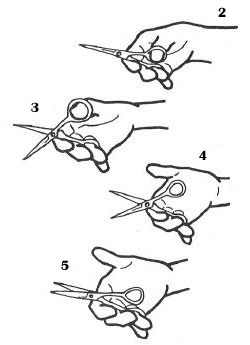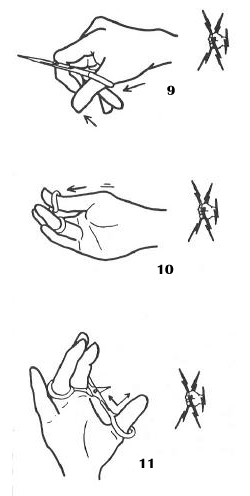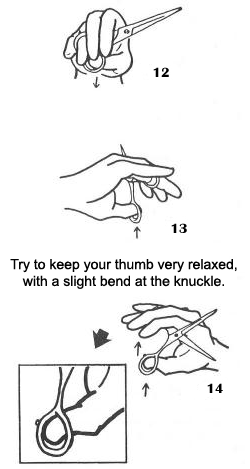
Congratulations on Purchasing the Finest Haircutting Scissors in the World!
Care and Maintenance Video
Due to their unique blade design, Hikari scissors must be maintained as outlined in the Hikari scissor owner's manual. Simple care and maintenance on a daily basis will ensure maximum performance from your Hikari scissor. Failure to perform proper care and maintenance can result in a damaged scissor and unsatisfactory performance.
If you have any questions about care and maintenance, please call us at 310-516-0350.
Correct Tension and Adjustment
Testing for correct tension should be performed daily, especially in the first two months of use. During this time, the washer in the pivot area will be settling and the tension on your scissor can loosen and need to be adjusted.
Do not use your scissors if the tension is incorrect. As the tension loosens on a scissor, the screw loosens and the blades begin to come apart. If you try to cut with scissors in this condition, they will bend or fold the hair. The only way scissors with loose tension can cut is if the blades are pushed together by using horizontal thumb pressure. In doing this, you can dull and nick your blades quickly.
Testing for correct tension:
• Hold scissor as if to execute scissor over comb technique. (No. 1)
• Turn hand over with thumb parallel to ceiling (your palm facing up). (No. 2)
• Open blades completely, by moving thumb (up) only. (No. 3)
• Remove thumb and allow weight of handles to close blades. (No. 4)
• Looking at the length of the blades, if the blades remain most of the way open, tension is correct. (No. 4)
• If the blades close half way, or more, the tension is too loose and tension adjustment procedure must be performed. (No. 5)
When correct tension is achieved, finish by performing cleaning and oiling section before using scissor.


Oiling and Cleaning
Oiling and Cleaning is an important practice that ensures your scissors perform consistently and remain accurate/sharp throughout its cutting life. A two-phase process, it involves cleaning and then lubrication of a scissor's major contact points, minimizing unnecessary wear and damage.
Why Oil and Clean Daily?
Daily oiling and cleaning will enhance the performance and extend the cutting life of your scissor. Regular cleaning and lubrication protects against rust and deterioration from chemical/moisture contact in the salon environment, build-up of bacteria attracting debris in the interior pivot and blade area, reduces friction from blade movement, and prolongs sharpness.
Between Clients
Using a soft cloth towel, thoroughly wipe scissor and blades after every haircut. This will reduce build-up of chemicals and debris, which can adversely affect the performance of your scissor throughout your workday.
Daily
At the end of each workday, before leaving the salon - With scissor in closed position, add one drop of oil to the side of the screw. This will lubricate the screw and pivot preventing unnecessary wear in this area. (No. 6)
Opening the scissor blades, add a line of oil to both inner surfaces of the blades. Carefully wipe excess from pivot to point. This lubricates all major contact points of the blades, prevents wear, and prolongs sharpness. (No. 7)
Add two or three drops of oil to the pivot area, opening and closing the blades three to five times. This allows the oil to draw out any debris trapped in the pivot. (No. 8) Then carefully wipe blade, pivot, and screw area of all excess oil. Oil will dry protecting all major contact points before the following workday.

Thumb Pressure and Technique
Don't Defeat The Design:
Pushing, pulling, exerting any force or horizontal pressure to cut only defeats the design of the scissor. Because Hikari's edge is on the inside of the blade, these techniques will result in premature wear of the blades, pivot area and in severe cases nicking and structural damage. (Nos. 9, 10 & 11)
Finger Rings
Many stylists have developed the habit of applying horizontal thumb pressure (pushing) to the handles of their dull scissors in order to force the scissor to cut properly. In fact, most scissors require a certain amount of horizontal thumb pressure in order to cut. Hikari scissors are designed to cut with no horizontal thumb pressure. Hikari recommends using a finger ring in the thumb opening (not the finger ring hole). This helps the user break the habit of applying horizontal thumb pressure, which is often unknowingly applied. If you notice your scissors dulling very quickly, you may be pushing with your thumb without realizing it. Check your technique and use a finger ring in the thumb opening to help remind yourself not to apply any horizontal pressure to the handles. In addition, make sure the tension is adjusted properly. This will not only help prevent premature wear of the blades, but it will also help to prevent stress from developing in your hand and wrist!
What is basic technique?
Basic Technique refers to what is generally accepted as correct practical application of scissors for cutting hair.
Why Practice Basic Technique?
Basic Technique will give you a point of reference from which to consistently execute hair design concepts. It allows maximum utilization of a scissors design features and cutting ability.
How Is Basic Technique Effective?
The best way to use your scissor is simple - With the thumb controlling the moving blade, use vertical movement cut. (Nos. 12, 13, &14) This technique allows the pressure generated from the pivot design and the sharpness of the blades to do all of the work. It keeps the hands and finger relaxed and in control, giving you more agility and radial freedom to move throughout the haircut.


Irreparable Damage
Hikari shears are designed and intended to cut human hair, Never cut any material other than hair with your scissor. This can result in irreparable damage.
Do's and Don'ts
A Check List of Helpful Reminders
Daily
Implement the following practices into your workday to get maximum utilization of your scissor.
Tension and Adjustment
Correct Basic Cutting Technique without Thumb Pressure
Oiling and Cleaning
Whether wet or dry, cut only clean human hair. Hair that is coated with product (hair spray, mousse, etc.) or chemicals (perm solution, relaxer) may cause the blades to nick or, in the case of chemicals, deteriorate and rust the blades rendering them irreparable.
Only cut human hair. Never wigs, nylon, paper, plastic or other materials. Even mannequin hair, labeled as 100% Human, can be treated with a coating that can damage the blades.
Keep your scissors away from clips, brushes, combs, and other implements, which can cause accidental damage to the blades.
Storing Your Scissors
When scissors are not being used keep blades in a closed position. This will reduce the chance of getting nicks or other damage to the blades.
Never use magnets to hold scissors in storage. This can magnetize the blades attracting undesirable dust and other particles.
How you store your scissor is very important. For adequate protection and ease of travel, your investment in a scissor case is a wise decision. The most important factor is that the scissor case keeps the tips of your scissor in a closed position. Only insert one scissor per slot and try not to overlap scissors.
Possible Solutions to Common Problems
Pushing/bending/folding/chasing the hair:
This is most often caused by one of two things:
•Tension is too loose. When you check the tension, if the scissor is closing halfway or more, the tension is too loose. This means that the screw in the pivot area is loosening and the blades will start to come apart. When this happens, because the blades are coming apart, the scissor can bend the hair rather than cut it. Many people who do not check or adjust the tension may start using their thumb to push the blades together to get them to cut. This will cause the blades to grind together and will dull them very quickly.
•The scissors are dull. Many factors can cause scissors to dull over time, including, but not limited to -
-
- cutting with the tension too loose
- applying too much thumb pressure and forcing the blades together
- cutting hair with product in it
- cutting excessively thick sections of dry hair (like cutting a whole ponytail, which can cause a lot of small nicks that dull the blade or throw off the balance)
Pinching/pulling the hair
This is caused by a nick on the blade. There are several ways that a nick can occur. The following are helpful tips for avoiding that.
•Try not to hit your scissor on a comb or clip
•When setting your scissors down, make sure the blades are completely closed.
•Don't cut anything other than human hair (even wigs labeled as being made of human hair are often treated with chemicals) it can cause damage to your blade.
•Try not to drop your scissors
It feels "crunchy" not smooth
If you can hear the scissor crunching or skipping when it cuts, this can mean that the blades have a lot of nicks on them and/or the scissors have become dull. The way you use and take care of your scissor can greatly affect its performance.
If you are experiencing problems with your scissor, contact our service or sales department to speak with a team member who can help you troubleshoot. You may need to send them in to be checked and serviced. (Click here for instructions on how to send your scissor in)